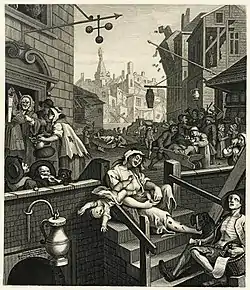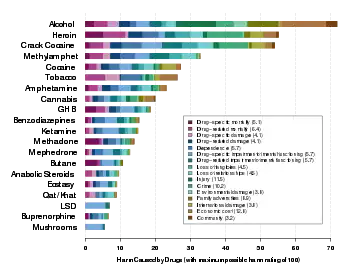Alcohol tolerance
Alcohol tolerance refers to the bodily responses to the functional effects of ethanol in alcoholic beverages. This includes direct tolerance, speed of recovery from insobriety and resistance to the development of alcohol use disorder.

Consumption-induced tolerance
Alcohol tolerance is increased by regular drinking.[1] This reduced sensitivity to the physical effects of alcohol consumption requires that higher quantities of alcohol be consumed in order to achieve the same effects as before tolerance was established. Alcohol tolerance may lead to (or be a sign of) alcohol dependence.[1]
Heavy alcohol consumption over a period of years can lead to "reverse tolerance". A liver can be damaged by chronic alcohol use, leading to a buildup of fat and scar tissue.[2] The reduced ability of such a liver to metabolize or break down alcohol means that small amounts can lead to a high blood alcohol concentration (BAC) and more rapid intoxication.
Physiology of alcohol tolerance

Direct alcohol tolerance is largely dependent on body size. Large-bodied people will require more alcohol to reach insobriety than lightly built people.[3] Thus men, being larger than women on average, will typically have a higher alcohol tolerance. The alcohol tolerance is also connected with activity of alcohol dehydrogenases (a group of enzymes responsible for the breakdown of alcohol) in the liver, and in the bloodstream.
High level of alcohol dehydrogenase activity results in fast transformation of ethanol to more toxic acetaldehyde. Such atypical alcohol dehydrogenase levels are less frequent in alcoholics than in nonalcoholics.[4] Furthermore, among alcoholics, the carriers of this atypical enzyme consume lower ethanol doses, compared to the individuals without the allele.
An estimated one out of twenty people have an alcohol flush reaction. It is not in any way an indicator for the drunkenness of an individual.[5][6] A mild flushing reaction occurs when the body metabolizes alcohol more quickly into acetaldehyde, a toxic metabolite.[4][7] A more severe flushing reaction occurs when the body metabolizes the acetaldehyde more slowly, generally due to an inactive aldehyde dehydrogenase enzyme. Both of those conditions—faster conversion of alcohol to acetaldehyde and slower removal of acetaldehyde—reduce the risk for excessive drinking and alcohol dependence.[4]
Alcohol tolerance in different ethnic groups
To engage in alcohol consumption and the development of an alcohol use disorder appear to be common to primates, and is not a specific human phenomenon.[8] Humans have access to alcohol on far greater quantity than non-human primates, and the availability increased particularly with the development of agriculture.[9] The tolerance to alcohol is not equally distributed throughout the world's population.[10] Genetics of alcohol dehydrogenase indicate resistance has arisen independently in different cultures.[11] In North America, Native Americans have the highest probability of developing an alcohol use disorder compared to Europeans and Asians.[12][13][14][15] Different alcohol tolerance also exists within Asian groups, such as between Chinese and Koreans.[16] The health benefits of a modest alcohol consumption reported in people of European descent appear not to exist among people of African descent.[17]
Higher body masses and the prevalence of high levels of alcohol dehydrogenase in an individual increase alcohol tolerance, and both adult weight and enzymes vary with ethnicity.[18][19] Not all differences in tolerance can be traced to biochemistry however.[20] Differences in tolerance levels are also influenced by socio-economic and cultural difference including diet, average body weight and patterns of consumption.[21][22]
Footnotes
- "Alcohol and Tolerance". National Institute on Alcohol Abuse and Alcoholism (NIAAA), Alcohol Alert (28). April 1995. Retrieved 2009-08-13.
- "Alcohol-Induced Liver Disease". UC San Diego Health. Retrieved 4 October 2020.
- "Factors That Affect How Alcohol is Absorbed & Metabolized". Student affairs - Office of Alcohol Policy and Education. Stanford University. Retrieved 26 May 2018.
- Hurley TD, Edenberg HJ (2012). "Genes encoding enzymes involved in ethanol metabolism". Alcohol Res. 34 (3): 339–344. PMC 3756590. PMID 23134050.
- "Myth or reality? The Asian alcohol 'gene' explained". Difford's Guide. September 10, 2013. Archived from the original on 2013-10-22. Retrieved 2013-10-22.
- "Identifying the Signs of Intoxication" (PDF). Government of Western Australia. December 2010. Archived from the original (PDF) on March 27, 2011.
- Eng, MY; Luczak, SE; Wall, TL (2007). "ALDH2, ADH1B, and ADH1C genotypes: A literature review". Alcohol Research & Health. 30 (1): 22–7. PMC 3860439. PMID 17718397.
- Juarez, J; Guzman-Flores, C; Ervin, FR; Palmour, RM (December 1993). "Voluntary alcohol consumption in vervet monkeys: individual, sex, and age differences". Pharmacology Biochemistry and Behavior. 46 (4): 985–8. doi:10.1016/0091-3057(93)90232-I. PMID 8309979. S2CID 33697201.
- "Racial Differences in Alcohol Sensitivity". Alcohol and Alcoholism. 1986-01-01. doi:10.1093/oxfordjournals.alcalc.a044598. ISSN 1464-3502.
- Chan, AW (1986). "Racial differences in alcohol sensitivity". Alcohol and Alcoholism (Oxford, Oxfordshire). 21 (1): 93–104. PMID 2937417.
- Osier, Michael V.; Pakstis, Andrew J.; Soodyall, Himla; Comas, David; Goldman, David; Odunsi, Adekunle; Okonofua, Friday; Parnas, Josef; et al. (2002). "A Global Perspective on Genetic Variation at the ADH Genes Reveals Unusual Patterns of Linkage Disequilibrium and Diversity". American Journal of Human Genetics. 71 (1): 84–99. doi:10.1086/341290. PMC 384995. PMID 12050823.
- "Alcohol Use Disorder". NY Times. 2013. Retrieved July 21, 2016.
- Mail & al. (eds., 2002): Alcohol Use Among American Indians and Alaska Natives: Multiple Perspectives on a Complex Problem. NIAAA Research Monograph No. 37. Bethesda, MD: National Institute on Alcohol Abuse and Alcoholism
- Caetano, Raul; Clark, Catherine L (1998). "Trends in Alcohol-Related Problems among Whites, Blacks, and Hispanics: 1984-1995". Alcoholism: Clinical and Experimental Research. 22 (2): 534–538. doi:10.1111/j.1530-0277.1998.tb03685.x.
- Karen Chartier; Raul Caetano. "Ethnicity and Health Disparities in Alcohol Research".
- Duranceaux & al. (2008). "Ethnic differences in level of response to alcohol between Chinese Americans and Korean Americans". J Stud Alcohol Drugs. 69 (2): 227–234. doi:10.15288/jsad.2008.69.227. PMC 2739570. PMID 18299763.
- Jackson, Chandra L.; Hu, Frank B.; Kawachi, Ichiro; Williams, David R.; Mukamal, Kenneth J.; Rimm, Eric B. (July 2015). "Black–White Differences in the Relationship Between Alcohol Drinking Patterns and Mortality Among US Men and Women". American Journal of Public Health. 105 (S3): S534–S543. doi:10.2105/AJPH.2015.302615. PMC 4455501. PMID 25905819.
- Yin, S. -J.; Cheng, T. -C.; Chang, C. -P.; Chen, Y. -J.; Chao, Y. -C.; Tang, H. -S.; Chang, T. -M.; Wu, C. -W. (1988). "Human stomach alcohol and aldehyde dehydrogenases (ALDH): A genetic model proposed for ALDH III isozymes". Biochemical Genetics. 26 (5–6): 343–60. doi:10.1007/BF00554070. PMID 3214414. S2CID 9315241.
- Fenna, D; Schaefer, O; Mix, L; Gilbert, JA (1971). "Ethanol metabolism in various racial groups". Canadian Medical Association Journal. 105 (5): 472–5. PMC 1931291. PMID 5112118.
- Bennion L.; Li T. K. (1976). "Alcohol metabolism in American Indians and whites". New England Journal of Medicine. 294 (1): 9–13. doi:10.1056/nejm197601012940103. PMID 1244489.
- Waldram, J. B.; Herring, A. & Young, K. (1995). Aboriginal Health in Canada: Historical, Cultural, and Epidemiological Perspectives. Toronto: University of Toronto Press. ISBN 9780802085795.
- Saggers, S. & Gray, D. (1998b). Dealing with Alcohol: Indigenous Usage in Australia, New Zealand and Canada. Cambridge: Cambridge University Press
References
- Carroll, Charles R. Drugs in Modern Society . NY: McGraw-Hill, 2000 (fifth ed.).
- Chesher, G.; Greeley, J. (1992). "Tolerance to the effects of alcohol". Alcohol, Drugs and Driving. 8 (2): 93–106.
- Osier, M; Pakstis, AJ; Kidd, JR; Lee, JF; Yin, SJ; Ko, HC; Edenberg, HJ; Lu, RB; Kidd, KK (1999). "Linkage disequilibrium at the ADH2 and ADH3 loci and risk of alcoholism". American Journal of Human Genetics. 64 (4): 1147–57. doi:10.1086/302317. PMC 1377839. PMID 10090900.
- Muramatsu, T; Wang, ZC; Fang, YR; Hu, KB; Yan, H; Yamada, K; Higuchi, S; Harada, S; Kono, H (1995). "Alcohol and aldehyde dehydrogenase genotypes and drinking behavior of Chinese living in Shanghai". Human Genetics. 96 (2): 151–4. doi:10.1007/BF00207371. PMID 7635462. S2CID 1624596.
- Neumark, YD; Friedlander, Y; Thomasson, HR; Li, TK (1998). "Association of the ADH2*2 allele with reduced ethanol consumption in Jewish men in Israel: A pilot study". Journal of Studies on Alcohol. 59 (2): 133–9. doi:10.15288/jsa.1998.59.133. PMID 9500299.
- Borinskaya, S. A.; Gasemianrodsari, F.; Kalyina, N. R.; Sokolova, M. V.; Yankovsky, N. K. (2005). "Polymorphism of Alcohol Dehydrogenase Gene ADH1B in Eastern Slavic and Iranian-Speaking Populations". Russian Journal of Genetics. 41 (11): 1291–4. doi:10.1007/s11177-005-0231-5. S2CID 4686166. Translated from "Polymorphism of alcohol dehydrogenase gene ADH1B in eastern Slavic and Iranian-speaking populations". Genetika. 41 (11): 1563–6. 2005. PMID 16358724.
- Borinskaya, Svetlana; Kal'Ina, Nina; Marusin, Andrey; Faskhutdinova, Gulnaz; Morozova, Irina; Kutuev, Ildus; Koshechkin, Vladimir; Khusnutdinova, Elza; et al. (2009). "Distribution of the Alcohol Dehydrogenase ADH1B∗47His Allele in Eurasia". American Journal of Human Genetics. 84 (1): 89–92, author reply 92–4. doi:10.1016/j.ajhg.2008.12.007. PMC 2668054. PMID 19124091.
- Li, Hui; Borinskaya, Svetlana; Yoshimura, Kimio; Kal’Ina, Nina; Marusin, Andrey; Stepanov, Vadim A.; Qin, Zhendong; Khaliq, Shagufta; et al. (2009). "Refined Geographic Distribution of the Oriental ALDH2*504Lys (nee 487Lys) Variant". Annals of Human Genetics. 73 (3): 335–45. doi:10.1111/j.1469-1809.2009.00517.x. PMC 2846302. PMID 19456322.
Further reading
- Caetano R, Clark CL, Tam T (1998). "Alcohol consumption among racial/ethnic minorities: theory and research" (PDF). Alcohol Health Res World. 22 (4): 233–41. PMC 6761890. PMID 15706749. Archived from the original (PDF) on June 16, 2015.
